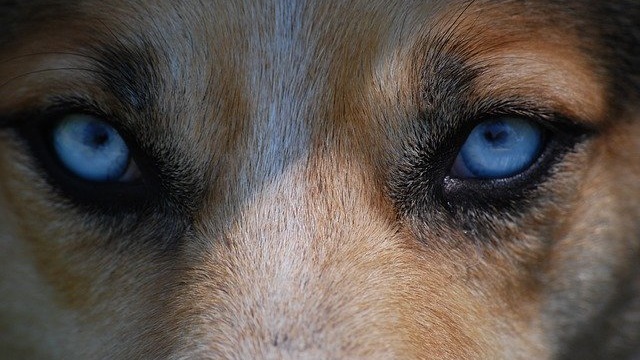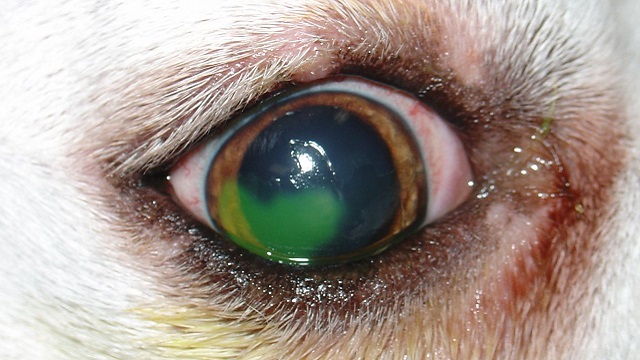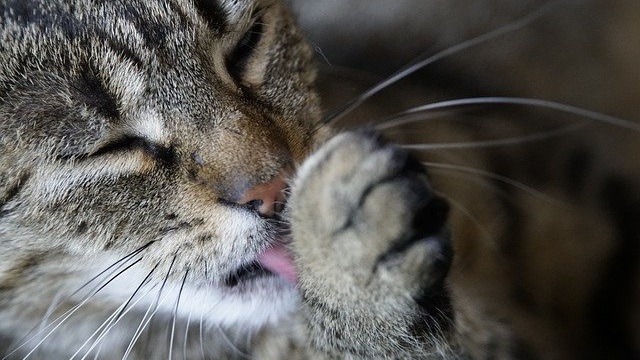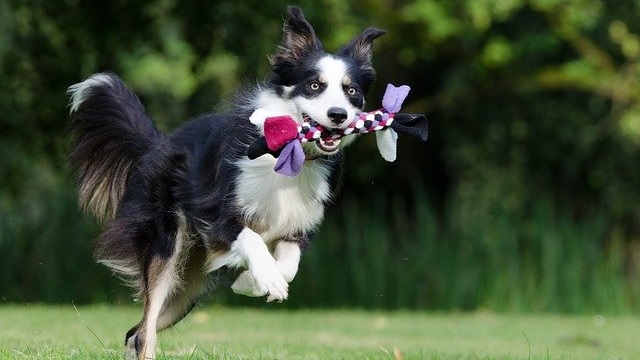Dog eye problems are unfortunately common and not only can they affect our buddy’s vision, they can be painful too. Spotting the problem early is thus very important. The sooner you realize something is wrong, the quicker you can act to reduce the dog’s pain and discomfort. Not to mention preventing the problem from developing into something more severe, such as full blindness. To help you out, here are the 8 most common dog eye problems and how to identify and treat them. ?
Cherry Eye

The cherry eye is the result of a congenital weakness of the ligaments of the third eyelid.
This eyelid in hidden in the inner corner of the eye and it’s usually invisible. However, when the ligaments are too weak to keep it in place, it can pop out, creating a cherry-like mass in the inner corner of the eye. ? Usually both eyes are affected over time, since this condition normally has a genetic basis.
How to identify it: little pink/reddish mass, similar to a cherry, in the inner corner of the eye.
How to treat it: it requires a simple surgery to attach the gland back to its normal position.
Corneal Wounds 
Corneal wounds or injuries are a common cause of dog eye problems, particularly in those canines who often run through high grass or play outdoors. ?
The cornea is a clear skin-like tissue that covers the surface of the eye. When dogs poke something into it, they can cut, puncture or provoke ulcers in this tissue, damaging the cornea and affecting the vision. Dogs with poor tear production are more at risk of contracting this eye problem.
How to identify it: most lacerations and wounds cannot be detected by the naked eye. Nevertheless, the dog’s behavior can give some indications. Due to the pain, dogs will often rub the affected eye or squint. Excessive drainage or redness may also occur.
How to treat it: antibiotic eye drops and ointments are usually enough to manage pain and to allow the cornea to heal itself. Surgery may also be needed in more severe cases, to repair the cornea.
Keratoconjunctivitis Sicca (KCS) or Dry Eye
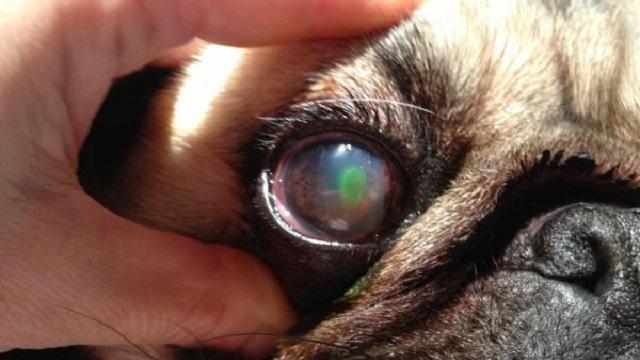
Tears have an important role in keeping the corneal tissue lubricated and removing dust from the eyes. Dry eyes occur when the tear glands don’t produce enough tears to fulfill their function. If the eye becomes too dry it can lead to discomfort, irritation and mucus discharge.
This condition can be the result of a congenital or physical problem with the tear glands, a virus or an immune system failure. In rare cases, it can also be a consequence of other dog eye problems such as cherry eye, particularly after surgery to treat this condition.
Breeds like the Bulldogs, Spaniels, Terriers and Pugs are more prone to have this eye problem.
How to identify it: irritated eyes, often red. Yellow mucus discharge is also common. Dogs can also suffer from chronic blinking and squinting.
How to treat it: KCS is a chronic disease. Mild cases can be managed through artificial tear eye drops or medication to stimulate tear production. ? In severe cases, vets can also perform surgery to direct the salivary duct to the eye, to ensure lubrication.
Conjunctivitis (Pink Eye)
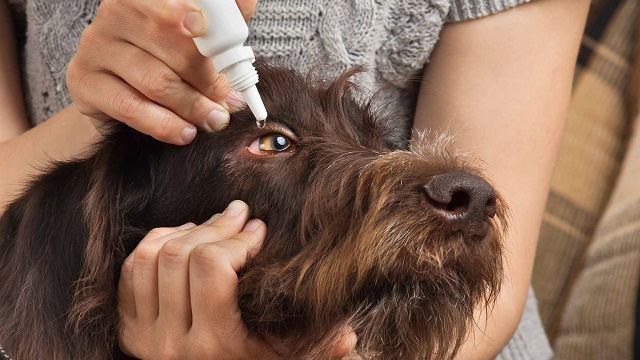
Conjunctivitis, often known as Pink Eye, is one of the most common dog eye problems. It arises when the conjunctiva, a mucus membrane that covers the inner surface of the eyelids, gets irritated or sore. The primary symptoms of conjunctivitis are red, irritated eyes, often swollen and with either watery or thick discharge.
Despite being one of the most common dog eye problems, conjunctivitis is often a symptom rather than a disease itself. It can be caused by a body infection, allergies, immune deficiency, tumors, injury, foreign bodies in the eyes or it can be a second symptom from dry eyes or entropion.
How to identify it: red and swollen eyes with watery or thick discharge. The dog can also show signs of discomfort. Nose discharge can also be a telling symptom. Check “Why do dogs have wet noses?” to learn more about nose wetness and when it becomes a problem.
How to treat it: OTC sterile saline washes can help clean the irritant bodies from the conjunctiva. In case of a bacterial or viral infection, it can be easily treated with antibiotic eye drops and ointments. If the problem doesn’t go away within 2 days, visit a vet to find the source and a more suitable treatment for the irritation. ?
Glaucoma
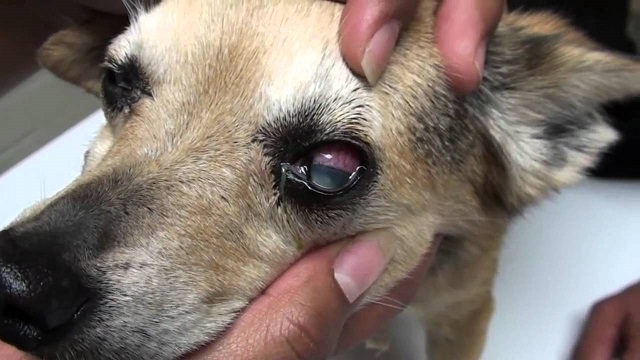
Within the eye, fluids are perfectly balanced to maintain a constant pressure. When this balance is disrupted the pressure increases, leading to one of the most disturbing and dangerous dog eye problems, the glaucoma.
The first symptoms are red eyes and increased tear production. These will quickly develop into dilated pupils and corneal cloudiness and, in severe cases, into an enlarged and protuberant eye. ?
How to identify it: cloudy cornea, dilated pupil and eye enlargement due to the excessive pressure over the eyeball.
How to treat it: contact a vet immediately if you suspect your dog may have glaucoma, as it can quickly develop into blindness if left untreated for too long. Normally, topical and oral medications are enough to treat inflammation and reduce the fluid pressure. Surgery may be required in severe cases.
Cataracts
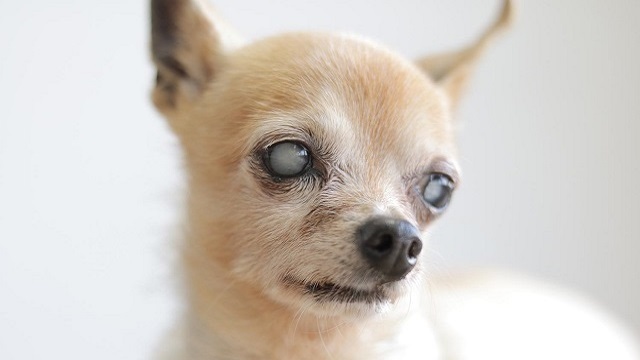
In the middle of the eye we have the pupil, a lens normally clear and black. Cataracts is a condition that develops in this lens, giving it a cloudy and opaque look and blocking the light from reaching the back of the eye. As a result, vision capacity is reduced and, in more severe cases, it can lead to total blindness. ?
How to identify it: black pupils develop a milky and white opaque appearance. The symptoms can easily be confused with those of normal ageing in dogs, but a vet can quickly tell them apart.
How to treat it: surgery is available for dogs with severely impaired vision, but cataracts are usually left untreated as they are painless and dogs can easily adapt to poor vision.
Entropion
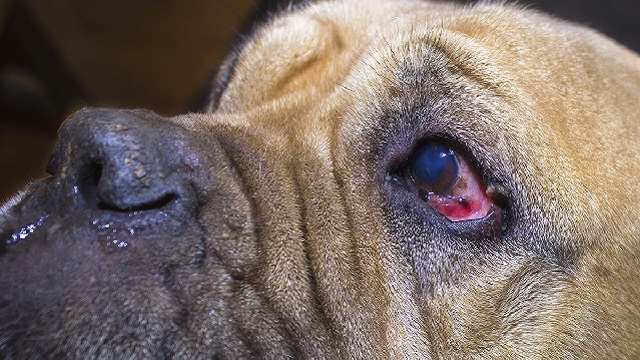
Entropion is a condition that results from dogs having eyelids that roll inwards. This eyelid movement can be congenital or develop as a consequence of squinting and rubbing the eyes.
When the eyelid rolls inward, it causes the hair to rub directly on the eye, which leads to pain, discharges and tearing. It can also eventually cause damage to the cornea.
How to identify it: because it’s rolled, the eyelid will be more protuberant around the eye. Pay attention also to increased tear production, mucus and eye redness.
How to treat it: for soft and mild cases, the vet can temporarily suture the eyelid in place. Severe cases may require surgery to repair the eyelid shape and fix it permanently.
Progressive Retinal Atrophy (PRA)
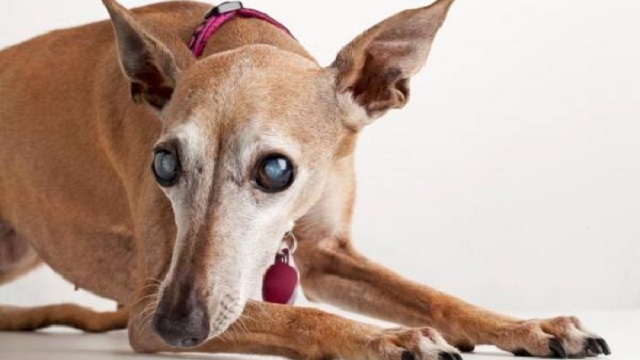
This is one of the most difficult dog eye problems to spot. As its name hints, PRA is triggered by the degeneration of retinal tissue, which cause dogs to gradually become blind. Unfortunately, there aren’t any visible symptoms of this disease.
How to identify it: night blindness is often the first visible symptom, but it is hard to spot as dogs tend to behave normally even with impaired vision.
How to treat it: there in no effective treatment for this condition, unfortunately. ? However, doctors stress that it is painless and dogs can adapt very well and quickly to losing their eyesight.
Dog eye problems are unfortunately common, but not dooming! Painful conditions should get our immediate attention, as well as signs that could indicate another disease. However, if your buddy is losing their sight, try not to feel like it’s the end of the world! We know it’s hard and obviously never want it to happen, but as long as your dog is healthy, vision is not that important. In fact, dogs are quick to adapt to vision impairment, since it’s not one of their main senses. So, try not to worry. We are sure their super amazing nose will still find you anywhere, even if they can’t see you. ?



